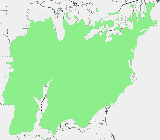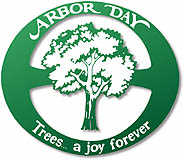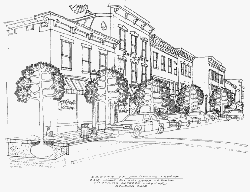



black oak
Quercus velutina
Black oak is a medium, deciduous tree with a mature height of 50 to 60 feet and variable spread. Excellent for wildlife, it is also useful for landscaping. Appropriate for medium yards, the specie does best on moist soils. Several minor pests may affect this specie, though most do not cause problems until the specie hits “old age” of 100 to 150 years. At this point several insect and fungal specie attack the tree as it declines. This is a good alternative to northern red oak in appearance.
Native Range:

Plant illustration by Dale Larison, Missouri Department of Conservation
Range map modified from USDA Forest Service Silvics of North America Web site - www.na.fs.fed.us/spfo/
pubs/silvics_manual/
Volume_2/quercus/
velutina.htm
New Standard Tree Planting Detail Handout

|
For the last several years I have been telling people about a root problem many trees have that is caused by us. This is Stem Girdling Roots (SGR). Most SGR´s are preventable by changing the way we have planted trees for the last several decades.
This involves finding the root flare (the area where the roots and trunk meet resulting in a flare) in the soil ball, removing the soil above the flare, digging the hole only deep enough so that the flare is at or slightly above the surrounding ground, then filling and taking excess soil off site.
MDC has developed a new “Standard Tree Planting Detail” handout to show how this is done. This handout is free to Missouri residents and may be copied and distributed. You may download it from www.geocities.com/rocksandtrees/thestump/april2005/standardtreeplantingdetail.pdf or contact me for a paper copy.
Arbor Day

|
The first Friday in April is the official Arbor Day in Missouri, April 1, 2005, this year and National Arbor Day is the last Friday in April (April 29, 2005). This does not mean your community must celebrate Arbor Day then. Your community can set Arbor Day any day you prefer.
Need more information or ideas for Arbor Day? The National Arbor Day Foundation provides the history of Arbor Day, teaching materials (many free), celebration ideas, and a free booklet titled “Celebrate Arbor Day Guidebook” and more on their web site at www.arborday.org/arborday/.
Tree Coffins
Tree Coffins was a term I learned this last Missouri Community Forestry Council

|
Cornell University has developed a new way to plant trees so they can not only survive, but thrive in these situations. The method is called structural soil. Structural soil not only allows the tree to be healthy, but allows the soil to be compacted to engineering standards for sidewalk overlays. The tree wins, the sidewalk is stable, and the community benefits from both.
The structural soil system will allow trees to be easily incorporated in parking lots, sidewalks, street medians, and other high traffic areas. To learn more about this innovation visit the Cornell Structural Soil site at www.hort.cornell.edu/uhi/outreach/csc/.
TRIM - Tree Resource Improvement and Maintenance Grant
TRIM applications were mailed out in late March 2005. These grant applications were sent to nearly every local government entity in Missouri. If you did not get an application, contact me and I will get you one.
TRIM grants are meant to encourage proper tree care and management. Several types of tree activities are eligible, but priority is given to ordinance development, management plan development, employee training, and others.
All applications must be signed by an MDC Forester by May 15, 2005 and postmarked by June 1, 2005 when sent to the MDC state office.
The history of past successful grants is that they received comment and assistance from their local MDC forester. This assistance was either direct or though a workshop. To provide this assistance, I will hold a TRIM Grant workshop on April 13, 2005. It will be held at Walter Woods Conservation Area at 9:30 AM until Noon. It is best if you have already started your application so we can address your specific questions. You must register for this workshop. Contact me at: Jon.Skinner@mdc.mo.gov or call 417-629-3423.